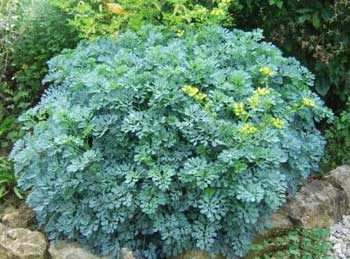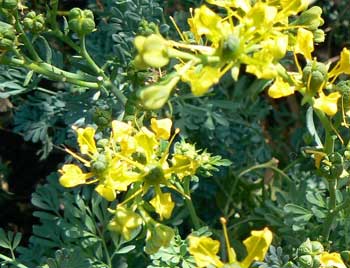Contents:
Common Names | Parts Usually Used | Plant(s) & Culture | Where Found | Medicinal Properties | Biochemical Information
Legends, Myths and Stories | Uses | Formulas or Dosages | How Sold | Warning | Bibliography
Scientific Names

- Ruta graveolens L.
- Rutaceae
- Rue family
Common Names
- Common rue
- Countryman’s treacle
- Garden rue
- Herby grass
- Herb-of-grace
- German rue
Parts Usually Used
The herb
Back to Top

Description of Plant(s) and Culture
Rue is an aromatic perennial plant; the branched, pale green, glabrous stem bears alternate pinnately decompound, somewhat fleshy leaves with oblong to spatulate leaflets. Small yellow or yellow-green flowers grow in paniculate clusters from June to August. Characterized by its pungent smell and bitter taste.
Back to Top
Where Found
Native to southern Europe and northern Africa and commonly cultivated in Europe and the United States, sometimes escaping to grow wild locally.
Back to Top
Medicinal Properties
Anthelmintic, carminative, emmenagogue, stimulant, stomachic, aromatic, tonic, antispasmodic
Back to Top
Biochemical Information
Essential oil, flavonoids, hyperine, rutin, hypericin, tannin, pectin, choline
Back to Top
Legends, Myths and Stories
Rue was well known to the ancients. Hippocrates (about 460-377 BC) commended rue for its medicinal qualities. Aristotle (384-322 BC) recorded that, because rue was considered good against evil and witches, the Greeks used it to combat the nervousness they experienced when they had to eat with foreigners, who were often suspected of having evil powers.
According to the Roman writer and naturalist Pliny (23-79 AD), painters, carvers, and engravers of his day ate rue to improve their eyesight.
The bitter herb rue traces its name to the Greek word ruta, meaning “repentance”. It has long been a symbol of sorrow and repentance and was called in Christian times the “herb of grace”, after the God-given grace that usually follows true repentance. Missionaries sprinkled holy water with brushes of rue.
Leonardo de Vinci and Michelangelo claimed that rue improved eyesight and helped artists find their inner vision.
The plant was also known in ancient times as an antidote against poisons. In the first century BC, the cunning and cultures King Mithridates VI of Pontus (an ancient country in northeastern Asia Minor) immunized himself against poison by taking rue in gradually increasing doses over an extended time.
In the Middle Ages, rue was considered a good defense against the plague and witches,, though many witches made use of it themselves in their enchantments. In the 16th and 17th centuries, rue was scattered on the floors of law courts as a fumigant, and judges carried branches of it to guard against jail fever.
Branches of Rue were kept in the house and carried around by the peasants during plagues. It was held in the front of the mouth when they spoke to one another. Rue was kept in their gardens because “the savour of Rue doth make serpents fly from the gardens and all other venomous beastes.”
Rue was a favorite flavor of Balkan races. They used it with discretion on cottage cheese, in soups, salads, and sauces.
A small branch of Rue was put in grape spirits, a native brandy known as Grappa, and sold in the Alpine regions of Cortina d’Ampezzo, St. Moritz, Chur, etc.
German sources say that if Rue is used as a head wash, it will kill lice.
Rue’s gray leaves served as a model for the suit of clubs in playing cards.
A favorite Balkan seasoning, rue can produce allergic reactions similar to poison ivy in some individuals, so it is best not to season dishes with rue for guests. Its taste is very bitter.
Back to Top
Uses
The main uses for rue are to relieve gouty and rheumatic pains and to treat nervous heart problems, such as palpitations in women going through the menopause. The infusion is also said to be useful in eliminating worms. In European folk medicine, rue serves to relieve gas pains and colic, improve appetite, relieve headache, and digestion, colic, gout, dizziness, pain in the joints, sciatica, resists poisons, and promote the onset of menstruation and relieve cramping. Rue can also be made into an ointment for external use against gout, rheumatism, and sciatica. An old English remedy: crush a handful of Rue leaves to a pulp and apply to wasp or bee stings.
Oil of rue is made by macerating the leaves in olive oil and may be used as ear drops to relieve earache.
The fresh plant juice extract may be applied directly to strengthen the eyes (check first for allergy). Fresh rue juice for eyes can be preserved and applied with honey. One drop of rue honey is administered to each eye 2 to 3 times daily. The infusion of leaves is a gargle for sore throat. Taken internally, the infusion is a carminative and diaphoretic for the treatment of stomach disorders, hysteria, spasms, convulsions, expel worms, removes pimples and warts, good for colds, flu and similar acute problems. Also lowers blood pressure. Applied externally, it is used to treat running sores.
Rue deters Japanese beetles. prevents attacks of fleas and other noxious insects. A pillow of dried rue leaves for a pet will prevent flea problems.
It was also placed or grown near stables or around manure piles to repel flies.
Back to Top
Formulas or Dosages
Infusion: steep 1 tsp. dried herb in 1/2 cup water. Take 1/2 cup a day.
Cold extract: soak 1 tsp. dried herb in 3/4 cup cold water for 10 hours and strain. Take 3/4 cup a day.
Tincture: a dose is from 5-20 drops.
Back to Top
How Sold
Rue’s active principle, rutin, is obtainable as rutin tea at most health food stores.
Back to Top
Warning
More than a small amount of rue taken internally can cause mild poisoning to anyone. Contact with the fresh plant may cause dermatitis in sensitive persons; (can produce allergic reactions similar to poison ivy) the juice is a local irritant. Rue is not to be used by pregnant women.
Do not boil Rue. Do not use if pregnant. Do not use in large doses.
Back to Top
Bibliography
![]() The Herb Book
The Herb Book, by John Lust, Bantam Books, 666 Fifth Avenue, New York, NY. copyright 1974.
![]() Back to Eden
Back to Eden, by Jethro Kloss; Back to Eden Publishing Co., Loma Linda, CA 92354, Original copyright 1939, revised edition 1994
![]() The Herbalist Almanac
The Herbalist Almanac, by Clarence Meyer, Meyerbooks, publisher, PO Box 427, Glenwood, Illinois 60425, copyright 1988, fifth printing, 1994
![]() Eastern/Central Medicinal Plants
Eastern/Central Medicinal Plants, by Steven Foster and James A. Duke., Houghton Mifflin Company, 215 Park Avenue South, New York, NY 10000
Herbal Gardening, compiled by The Robison York State Herb Garden, Cornell Plantations, Matthaei Botanical Gardens of the University of Michigan, University of California Botanical Garden, Berkeley., Pantheon Books, Knopf Publishing Group, New York, 1994, first edition
 The Magic of Herbs
The Magic of Herbs, by David Conway, published by Jonathan Cape, Thirty Bedford Square, London, England. (Out of print)
![]() Planetary Herbology
Planetary Herbology, by Michael Tierra, C.A., N.D., O.M.D., Lotus Press, PO Box 325, Twin Lakes. WI 53181., Copyright 1988, published 1992
![]() The Complete Medicinal Herbal
The Complete Medicinal Herbal, by Penelope Ody, Dorling Kindersley, Inc, 232 Madison Avenue, New York, NY 10016, First American Edition, copyright 1993
 Old Ways Rediscovered
Old Ways Rediscovered, by Clarence Meyer, Meyerbooks, publisher, PO Box 427, Glenwood, Illinois 60425, published from 1954, print 1988
![]() Indian Herbalogy of North America
Indian Herbalogy of North America, by Alma R. Hutchens, Shambala Publications, Inc., Horticultural Hall, 300 Massachusetts Avenue, Boston, Massachusetts 02115, 1973
![]() American Folk Medicine
American Folk Medicine, by Clarence Meyer, Meyerbooks, publisher, PO Box 427, Glenwood, Illinois 60425, 1973
![]() Culpeper’s Complete Herbal & English Physician: Updated With 117 Modern Herbs
Culpeper’s Complete Herbal & English Physician: Updated With 117 Modern Herbs, by Nicholas Culpeper, Meyerbooks, publisher, PO Box 427, Glenwood, Illinois 60425, 1990, (reprint of 1814)
![]() The Yoga of Herbs: An Ayurvedic Guide to Herbal Medicine
The Yoga of Herbs: An Ayurvedic Guide to Herbal Medicine, by Dr. David Frawley & Dr. Vasant Lad, Lotus Press, Twin Lakes, Wisconsin, Second edition, 1988.
![]() Webster’s New World Dictionary
Webster’s New World Dictionary, Third College Edition, Victoria Neufeldt, Editor in Chief, New World Dictionaries: A Division of Simon & Schuster, Inc., 15 Columbus Circle, New York, NY 10023
 The Magic of Herbs in Daily Living
The Magic of Herbs in Daily Living, by Richard Lucas, Parker Publishing Co. (1988).
 The Rodale Herb Book: How to Use, Grow, and Buy Nature’s Miracle Plants (An Organic gardening and farming book)
The Rodale Herb Book: How to Use, Grow, and Buy Nature’s Miracle Plants (An Organic gardening and farming book), edited by William H. Hylton, Rodale Press, Inc. Emmaus, PA, 18049., 1974
![]() Country Home Book of Herbs
Country Home Book of Herbs, Meredith Books, Editorial Dept. RW240, 1716 Locust Street, Des Moines, IA 50309-3023, copyright 1994
